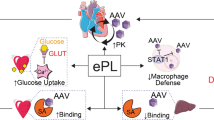Abstract
Lipid nanoparticle (LNP)-coated-modified RNA(modRNA) has been developed for enhancing the stability of modRNA, but it tends to accumulate in liver. The current study aimed to optimize strategy for increasing cardiac expression efficiency of modRNA. We synthesized Luciferase (Luc)-modRNA, and also developed 122Luc modRNA, a liver silencing Luc modRNA. Intramyocardial injection of naked Luc modRNA induced high bioluminescence signal in heart, but very low in other organs including liver. Luc modRNA-LNP injection showed the signal was increased by 5 folds in the heart and by 15,000 folds in the liver, compared to naked Luc modRNA group. In comparison with Luc modRNA-LNP group, the liver signal was decreased to 0.17%, while cardiac signal showed a slight drop by intramyocardial injection of 122Luc-modRNA-LNP. Our data revealed that intramyocardial injection of naked modRNA could effectively induced cardiac-specific expression. For cardiac delivery of Luc modRNA-LNP, 122modRNA-LNP enhances specificity of cardiac expression by abolishing liver signal.





Similar content being viewed by others
Data Availability
All data generated or analyzed during this study are included in this article. The datasets used and/or analyzed during the current study are available from the corresponding author on reasonable request.
References
Roth GA, Abate D, Abate KH, Abay SM. Abbafati C, Abbasi N. Global, regional, and national age-sex-specific mortality for 282 causes of death in 195 countries and territories, 1980–2017: a systematic analysis for the Global Burden of Disease Study 2017. Lancet. 2018;392(10159):1736–1788. https://www.ncbi.nlm.nih.gov/pmc/articles/PMC6227606/.
Ding J, Lin ZQ, Jiang JM, Seidman CE, Seidman JG, Pu WT, et al. Preparation of rAAV9 to overexpress or knockdown genes in mouse hearts. J Vis Exp. 2016;(118). https://www.ncbi.nlm.nih.gov/pmc/articles/PMC5226409/. Accessed 20 Dec 2022.
Liao HS, Kang PM, Nagashima H, Yamasaki N, Usheva A, Ding B, et al. Cardiac-specific overexpression of cyclin-dependent kinase 2 increases smaller mononuclear cardiomyocytes. Circ Res. 2001;88(4):443–50. https://www.ahajournals.org/doi/10.1161/01.res.88.4.443?url_ver=Z39.88-2003&rfr_id=ori:rid:crossref.org&rfr_dat=cr_pub%20%200pubmed.
Zangi L, Lui KO, von Gise A, Ma Q, Ebina W, Ptaszek LM, et al. Modified mRNA directs the fate of heart progenitor cells and induces vascular regeneration after myocardial infarction. Nat Biotechnol. 2013;31(10):898–907. https://www.ncbi.nlm.nih.gov/pmc/articles/pmid/24013197/.
Anttila V, Saraste A, Knuuti J, Jaakkola P, Hedman M, Svedlund S, et al. Synthetic mRNA encoding VEGF-A in patients undergoing coronary artery bypass grafting: design of a phase 2a clinical trial. Mol Ther Methods Clin Dev. 2020;18464–472. https://www.ncbi.nlm.nih.gov/pmc/articles/pmid/32728595/. Accessed 20 Dec 2022.
Carlsson L, Clarke JC, Yen C, Gregoire F, Albery T, Billger M, et al. Biocompatible, purified VEGF-A mRNA improves cardiac function after intracardiac injection 1 week post-myocardial infarction in swine. Mol Ther Methods Clin Dev. 2018;9330–346. https://www.ncbi.nlm.nih.gov/pmc/articles/pmid/30038937/. Accessed 20 Dec 2022.
Sultana N, Magadum A, Hadas Y, Kondrat J, Singh N, Youssef E, et al. Optimizing cardiac delivery of modified mRNA. Mol Ther. 2017;25(6):1306–1315. https://www.ncbi.nlm.nih.gov/pmc/articles/pmid/28389322/.
Turnbull IC, Eltoukhy AA, Fish KM, Nonnenmacher M, Ishikawa K, Chen J, et al. Myocardial delivery of lipidoid nanoparticle carrying modRNA induces rapid and transient expression. Mol Ther. 2016;24(1),66–75. https://www.ncbi.nlm.nih.gov/pmc/articles/pmid/26471463/.
Turnbull IC, Eltoukhy AA, Anderson DG, Costa KD. Lipidoid mRNA nanoparticles for myocardial delivery in rodents. Methods Mol Biol. 2017;1521153–166. https://www.ncbi.nlm.nih.gov/pmc/articles/PMC5541997/. Accessed 20 Dec 2022.
Paulis LE, Geelen T, Kuhlmann MT, Coolen BF, Schäfers M, Nicolay K, et al. Distribution of lipid-based nanoparticles to infarcted myocardium with potential application for MRI-monitored drug delivery. J Control Release. 2012;162(2),276–85. https://linkinghub.elsevier.com/retrieve/pii/S0168-3659(12)00535-4.
Pardi N, Tuyishime S, Muramatsu H, Kariko K, Mui BL, Tam YK, et al. Expression kinetics of nucleoside-modified mRNA delivered in lipid nanoparticles to mice by various routes. J Control Release. 2015;217345–51. https://www.ncbi.nlm.nih.gov/pmc/articles/PMC4624045/. Accessed 20 Dec 2022.
Jain R, Frederick JP, Huang EY, Burke KE, Mauger DM, Andrianova EA, et al. MicroRNAs enable mRNA therapeutics to selectively program cancer cells to self-destruct. Nucleic Acid Ther. 2018;28(5):285–296. https://www.ncbi.nlm.nih.gov/pmc/articles/PMC6157376/.
Sultana N, Sharkar MTK, Hadas Y, Chepurko E, Zangi L. In vitro synthesis of modified RNA for cardiac gene therapy. Methods Mol Biol. 2021;2158281–294. http://dx.doi.org/10.1007/978-1-0716-0668-1_21
Sahin U, Karikó K, Türeci Ö. mRNA-based therapeutics--developing a new class of drugs. Nat Rev Drug Discov. 2014;13(10),759–80. https://www.nature.com/articles/nrd4278.
Lee BL, Barton GM. Trafficking of endosomal Toll-like receptors. Trends Cell Biol. 2014;24(6):360–9. https://www.ncbi.nlm.nih.gov/pmc/articles/PMC4037363/.
Semple SC, Klimuk SK, Harasym TO, Dos Santos N, Ansell SM, Wong KF, et al. Efficient encapsulation of antisense oligonucleotides in lipid vesicles using ionizable aminolipids: formation of novel small multilamellar vesicle structures. Biochim Biophys Acta. 2001;1510(1–2):152–66. https://linkinghub.elsevier.com/retrieve/pii/S0005-2736(00)00343-6.
Acknowledgements
We think Bingyu Li and Guoping Zhang for technical support for this study.
Funding
This study was support by the National Natural Science Foundation of China (82070232) and Program of Shanghai Academic Research leader (21XD1403300 for Hui Gong and 22XD1423300 for Yuxiang Dai).
Author information
Authors and Affiliations
Corresponding authors
Ethics declarations
Ethics Approval
All animal experiments were followed and approved by the Institutional Animal Use and Care Committee of Zhongshan Hospital, Fudan University. No human studies were carried out by the authors for this article.
Conflict of Interest
The authors declare no competing interests.
Additional information
Associate Editor Guoping Li oversaw the review of this article.
Publisher's Note
Springer Nature remains neutral with regard to jurisdictional claims in published maps and institutional affiliations.
Supplementary Information
Below is the link to the electronic supplementary material.
Rights and permissions
Springer Nature or its licensor (e.g. a society or other partner) holds exclusive rights to this article under a publishing agreement with the author(s) or other rightsholder(s); author self-archiving of the accepted manuscript version of this article is solely governed by the terms of such publishing agreement and applicable law.
About this article
Cite this article
Huang, C., Jia, J., Jin, K. et al. Optimization of Strategy for Modified mRNA Inducing Cardiac-Specific Expression in Mice. J. of Cardiovasc. Trans. Res. 16, 1078–1084 (2023). https://doi.org/10.1007/s12265-023-10392-8
Received:
Accepted:
Published:
Issue Date:
DOI: https://doi.org/10.1007/s12265-023-10392-8




